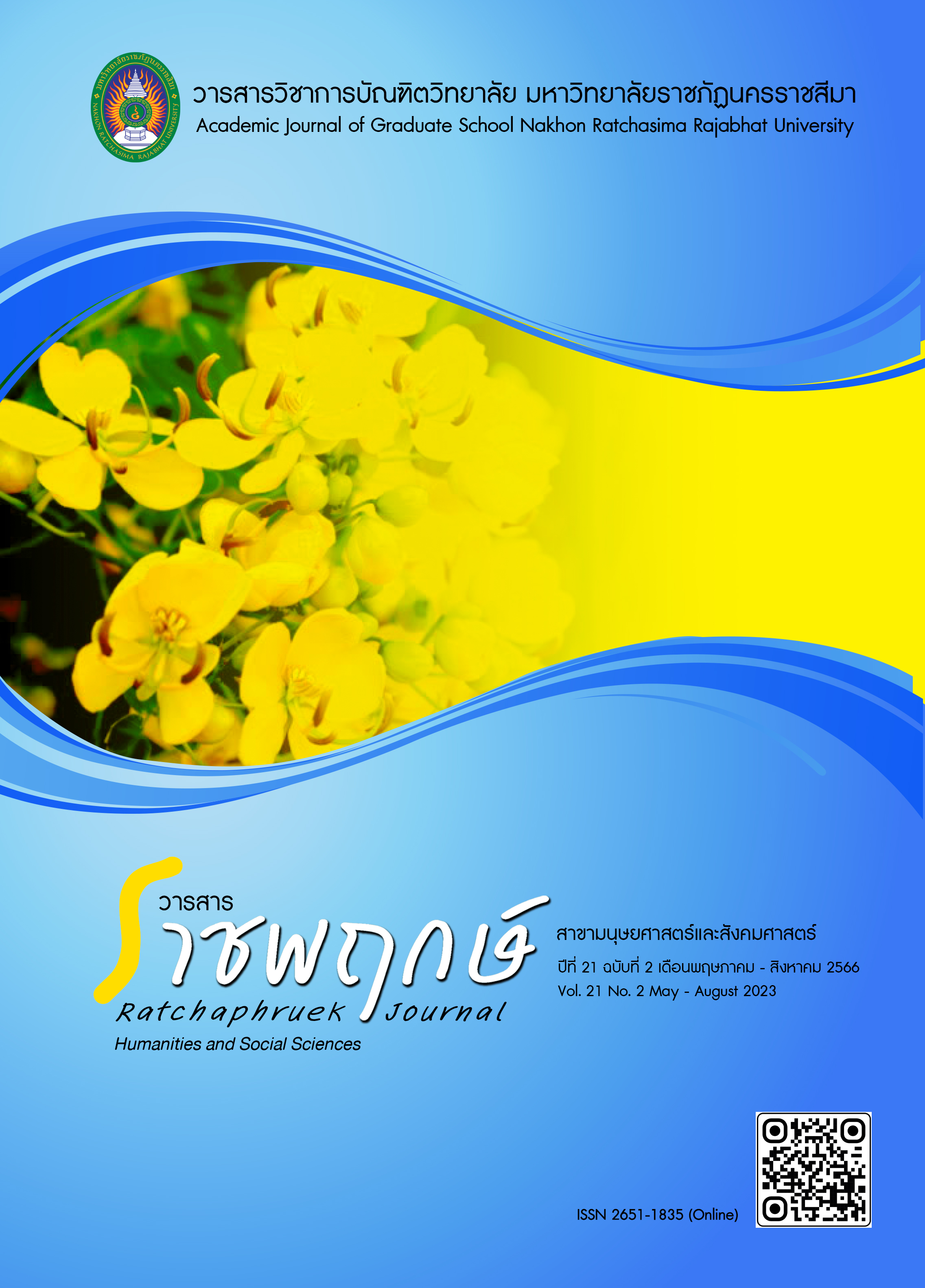The Development of a Program to Enhance Adversity Quotient Based on the Concept of Contemplative Education for Junior High School Students
Main Article Content
Abstract
This study is the research and development that have the purpose to develop and study the results of using the program to enhance Adversity Quotient. According to the concept of contemplative education for junior high school students. A sample of 21 students by a cluster or area random sampling. The tools used were the adversity Quotient test. The index of item-objective congruence (IOC) was 0.60-1.00, the Item–Total Correlation was 0.21-0.77 and Cronbach’s alpha Coefficient was 0.89, which were measured before and after the experiment. The satisfaction questionnaire was analyzed by using mean, standard deviation, dependent samples t–test. The research results found that the program has content on Adversity Quotient in 4 aspects: 1) Controlling 2) Origin and Ownership, 3) Reaching, and 4) Endurance, which contain 14 activities. The learning management process had 5 steps: 1) Conscious preparation, 2) Learning through experience, 3) Reflection learning, 4) Ingenious consideration, and 5) Application. The quality of the program suitability overall was at a high level, (= 4.50, S.D. = 0.58) and the possibility was at the highest level. (
= 4.52, S.D. = 0.57). The results of the program trial showed that Adversity Quotient of the sample after the experiment was higher than before. It was statistically significant at the .01 level. The samples were satisfied with the program overall was at a high level. (
= 4.05, S.D. = 0.78)
Article Details

This work is licensed under a Creative Commons Attribution-NonCommercial-NoDerivatives 4.0 International License.
References
เกศรา น้อยมานพ. (2561). การพัฒนาความสามารถในการเผชิญปัญหาและฝ่าฟันอุปสรรคของนักเรียนมัธยมศึกษาตอนต้น โดยการใช้กิจกรรมกลุ่มสัมพันธ์. วารสารการศึกษาและการพัฒนาสังคม, 14(1), น. 583-592. สืบค้นเมื่อ 28 มกราคม 2562, จาก https://tdc.thailis.or.th/ tdc/dccheck.php?Int_code=95&RecId=29581&obj_id=185577&showmenu=no&userid=0.
จิรัฐกาล พงศ์ภคเธียร. (2553). จิตตปัญญาศึกษา: การเรียนรู้สู่จิตสานึกใหม่. กรุงเทพฯ: สวนเงินมีมา.
บุญชม ศรีสะอาด. (2560). การวิจัยเบื้องต้น (พิมพ์ครั้งที่ 10). กรุงเทพฯ: สุวีริยาสาส์น.
ปิยะธิดา ปัญญา. (2560). สถิติสำหรับวิจัย. มหาสารคาม: ตักสิลาการพิมพ์.
ประพันธ์ ขันโมลี, อรัญ ซุยกระเดื่อง และปิยะธิดา ปัญญา. (2564). การพัฒนาโปรแกรมเสริมสร้างสมรรถนะการประเมินการอ่าน คิดวิเคราะห์ และเขียนสำหรับครู ระดับมัธยมศึกษา. วารสารมหาวิทยาลัยราชภัฏมหาสารคาม, 14(2), น. 145-158 สืบค้นเมื่อ 10 ตุลาคม 2565, จาก http://so02.tci-thaijo.org/index.php/rmuj/view/16774
ประเวศ วะสี. (2555). จิตตภาวนากับการเปลี่ยนแปลงขั้นพื้นฐาน. นครปฐม: มหาวิทยาลัยมหิดล.
ผู้จัดการออนไลน์. (2561). ชีวิตดีได้ด้วย AQ. สืบค้นเมื่อ 28 เมษายน 2566, จาก https://dmh.go.th/news-dmh/view.asp?id=28163
ไพศาล วรคำ. (2564). การวิจัยทางการศึกษา (พิมพ์ครั้งที่ 13). มหาสารคาม: ตักสิลาการพิมพ์.
ศิริธร ศรีจำนงค์. (2557). การพัฒนาหลักสูตรเพื่อเสริมสร้างจิตสาธารณะ สำหรับนักเรียนมัธยมศึกษาตอนต้น ตามแนวจิตตปัญญาศึกษา (วิทยานิพนธ์ดุษฎีบัณฑิต, มหาวิทยาลัยมหาสารคาม).
อุทัย วรสาร, ปิยะธิดา ปัญญา และไพศาล วรคำ. (2561). การวิจัยและพัฒนาโปรแกรมเสริมสร้างแรงจูงใจในการดำรงชีวิต ตามหลักปรัชญาของเศรษฐกิจพอเพียง. วารสารครุศาสตร์ มหาวิทยาลัยราชภัฏมหาสารคาม, 15(20), น. 385-398.
อรัญ ซุยกระเดื่อง. (2559). สถิติสำหรับการวิจัย. มหาสารคาม: คณะครุศาสตร์ มหาวิทยาลัยราชภัฏมหาสารคาม.
อริสา สุมามาลย์. (2562). การพัฒนากระบวนการจัดการศึกษานอกระบบโรงเรียนบนฐานแนวคิดจิตตปัญญาศึกษา เพื่อเสริมสร้างเป้าหมายในชีวิตสำหรับนักศึกษาระดับปริญญาตรี (วิทยานิพนธ์ดุษฎีบัณฑิต, จุฬาลงกรณ์มหาวิทยาลัย).
Barr, M. J. and Keating L. A. (1990). Introduction: Elements of program development In M. J. Barr, L.A Keating and Associates. Developing Effective Student Services Programs. San Francisco: Jossey-Bass.
Bloom B. S. (1956). Taxonomy of educational objectives. New York: David Mckay.
Boone. E. J. (2002). Developing programs in education. Illinois: Waveland Press.
Breslin, F. C., Zack, M. & McMain, S. (2002). An Information-processing analysis of mindfulness: Implication for relapse prevention in the treatment of substance abuse. Clinical Psychology: Science and Practice, 9 (3), pp. 275-299. Retrieved August 28, 2022, from https://doi.org/10.1093/clipsy.9.3.275
CMind. (2017). The Tree of Contemplative Practices [Illustration]: The Center for Contemplative Mind in Society. Retrieved April 8, 2017, from https://www. contemplativemind.org/practices/tree
Corcoran, K. M., Farb, N., Anderson, A. and Segal, Z. V. (2010). Mindfulness and emotion regulation: Outcomes and possible mediating mechanisms. Retrieved May 20, 2022, from https://www.researchgate.net/publication/232556639
Dewey, J. (1983). Experience and education. New York: Collier.
Harrow, A. (1972). A taxonomy for psychomotor Domain: A guide for developing Behavioral objectives. New York: Longman.
Joyce, B. and Weil, M. (2009). Models of teaching (7th ed.). Boston: Pearson Education Allyn and Bacon.
Kolb, A. D. (1984). Experiential learning: Experience as the source of learning and development. United States of America: Prentice Hall.
Stoltz, P. G. (1997). Adversity quotient: Turning obstacles into opportunities. New York: United Stages of America.
Stromborg, M. F. (1984). Selecting an Instrument to Measure Quality of Life. Oncology Nursing Forum, 11(5), pp. 88-91.


